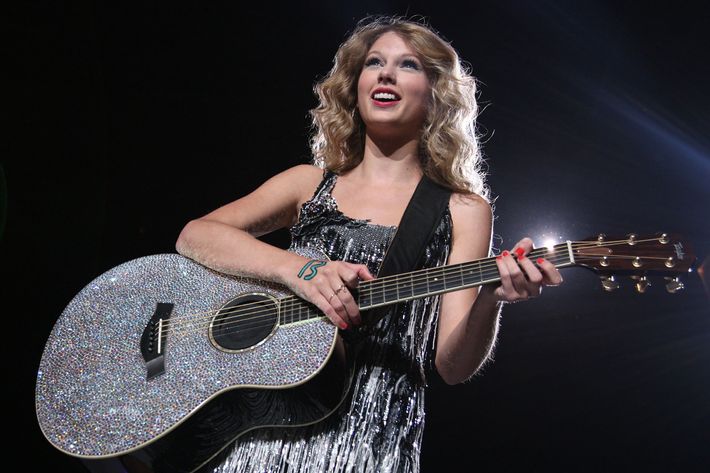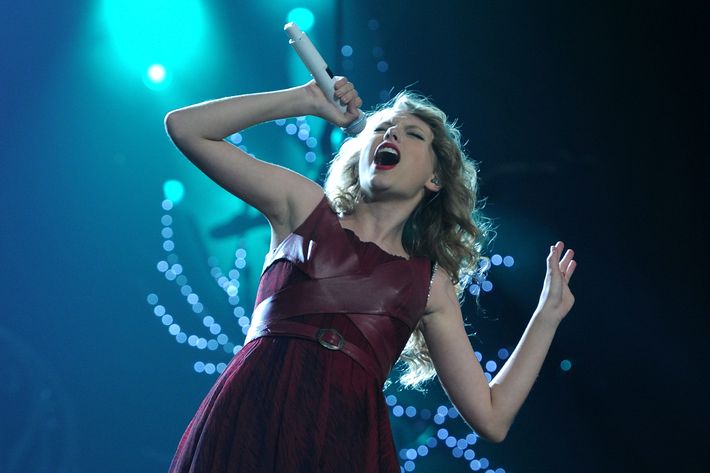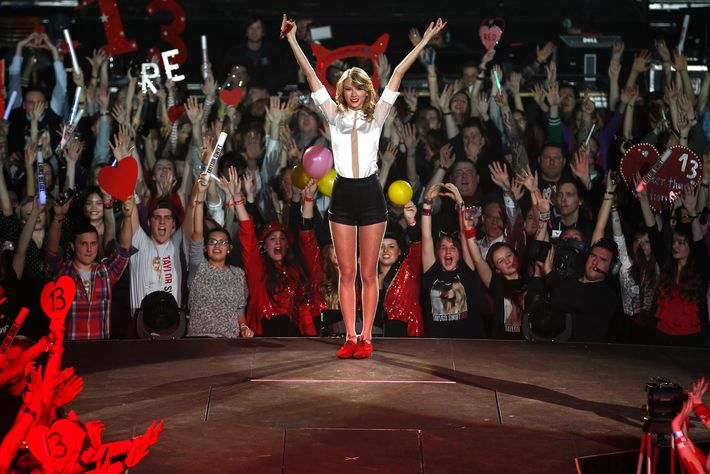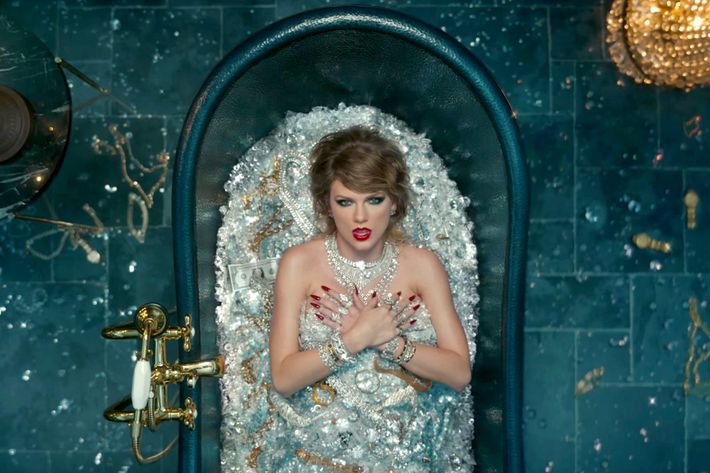
Taylor Swift became hugely famous in 2014 — or, more accurately, the person she plays in her music did. Regarded as her pivot from country to capital-P pop, 1989 also marked a different, but related, turn: It’s the first album set fully and explicitly within the context of her fame. The Nashville singer turned New Yorker built her career on songs engineered to maximize their relatability, a strategy that can work for pop but finds more success in country. She sang hits from the perspective of a misfit high-schooler sulking on the bleachers, or the lovelorn 20-something nursing the empty space left over from a breakup, neither a particularly glamorous scenario. These songs took place in our world, not Taylor’s; even when she cracked open the fourth wall on Red’s “We Are Never Ever Getting Back Together,” musing about her ex listening to an indie record “that’s much cooler than mine,” she was self-deprecating. When she contemplated the disappearance of a star on “The Lucky One,” she looked into fame as if it were her future, not her present. Despite all evidence to the contrary, before she released 1989, Taylor Swift had not yet become a pop star.
From its first single, 1989 positioned itself as an album about being looked at. Swift sang on “Shake It Off” as someone aware of what people say about her, and though the song’s shoehorned moral dictates that the gossip doesn’t matter, we all know the power of looking, even Taylor. Especially Taylor. Who else would write a dazzling hit about falling for her ex and then use five-sixths of his last name as the title? This wasn’t an album that casually invited speculation. It left almost no room for speculation after all the hints it dropped. Its bizarre tourism jingle of an opener wasn’t just this decade’s most obvious product placement; it also painted an explicit backdrop for all the songs that followed, as if inviting you to pin each lyric to a paparazzi photo. Swift even described her outfits to give you a head start.
If country music aims to be relatable, to take even a relationship with another A-lister and boil it down to its gritty human elements like Swift did with “Dear John,” then pop indulges the aspirational. It’s not about who you are or even who you might become, but who you’d like to inhabit for the three-and-a-half minutes the song plays in the bar, in the Forever 21, over the car stereo. Even Lorde’s anti-opulence screed “Royals,” whose influence can be heard all over 1989, invites you into a space where you can imagine not caring about money or the habits of the rich. It’s a reply to the aspirations of other pop songs, but aspirational all the same.
In crafting her aspirational plane, Swift focused on the transition from her country persona to her pop presence, highlighting the seismic shifts that come with accumulating a formidable amount of celebrity. Unlike pop songs that entertain the idea of fame or wealth as their singers’ birthright, 1989 asked its listeners to imagine how bizarre it would be if they woke up tomorrow with a Manhattan condo and a boyfriend who is a member of One Direction. Swift sang as though dazzled by the flashbulbs that had been trained on her for years; her rise to fame was slow, but the acknowledgement of it in her music came suddenly. On “I Know Places,” she situates a romantic getaway as an escape from the paparazzi in none too subtle terms: “They are the hunters / We are the foxes / And we run.” “Bad Blood” opened new territory as her first explicit diss track, a catchy, aggressive drama about a feud between two extremely famous people whose reverberations have unfortunately reached all the way to 2017.
The novelty of Swift’s 1989 persona helped the album sell like it was the ’90s again, and the fact that it sounded like the ’90s didn’t hurt, either. She had a tricky balance to strike: Hire one of the Yeezus producers and squeeze in a few hip-hop verses and she’d risk sounding too trendy, too try-hard — but hew too close to the clipped country-pop of Red and she’d stagnate. (Kendrick Lamar showed up in a remix seven months after she’d sold over a million copies in her first week. It felt more like an afterthought and an experiment than a marketing strategy.)
Instead of mimicking what was already on the radio, Swift leaped back in time, drawing on ’90s Madonna and Mariah Carey (even a little Sheryl Crow on “This Love” and “How You Get the Girl”), making her bid as the kind of historic pop superstar that had already been relegated to anachronism. If “Blank Space” and “Out of the Woods” sound mysteriously like Christmas songs, it’s only because “All I Want For Christmas Is You” has been indelibly imprinted on the psyche of every single American kid born in 1989. Swift didn’t outsell her peers ten-to-one by tapping into the present. She invested in the past, its booming drum machines and Polaroid snapshots, and reaped the nostalgic rewards.
The way music celebrity — and fans’ investment in it — has changed since the ’90s never seemed to sink into Swift’s music. It’s telling that the font on the cover of her forthcoming album, Reputation, comes from the New York Times rather than, say, BuzzFeed. Despite her newsmaking Instagram presence, Swift continues to sing about her fame as though it’s situated ever so slightly in the past, when pop empires were more secure and entire narratives couldn’t be undermined by a single Snapchat video. 1989 banked on its listeners’ nostalgia, whether for a time they’d actually lived through or a time they wished they had, but it also revealed a streak of nostalgia in Swift herself. She still uses James Dean as a reference point, a name that more and more teens will have to read up on via Genius annotation. She’d rather see her life, as she plays it in her songs, as a classic movie, not an Instagram story. It’s a simpler vision of fame to inhabit, one without gossip blogs and cell-phone cameras, but if Swift’s recent singles tell us anything, it’s that denying the world as it is only makes it harder to shake it all off.









